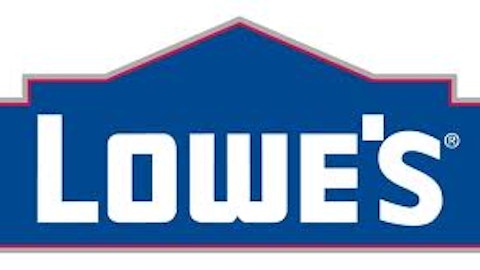This is the company’s most important initiative for 2013, and by the end of the first quarter the inventory resets had taken place for around 50% of its business. The remainder will happen throughout the year. However, the benefits will flow in once the sales of reset items have stabilized. At the end of the first quarter, Lowe’s has stabilized approximately 30% of the merchandise.
This initiative may turn out to be an important comps booster over the coming quarters. It is true that like all transitions, the company is having some teething issues to make this operational. Once a product line is stabilized, however, management expects to see average mid-single digit comps and roughly 100 basis points of margin improvement rate for the same.
More customer orientation
Lowe’s Companies, Inc. (NYSE:LOW) has recruited more staff for customer-facing roles. This means that it will have more staff on its shop floor during peak weekday hours to assist the customers and provide better services. The company is planning this out to ensure that there is an adequate focus on areas and products that offer more opportunities.
Lowe’s is implementing this initiative in a phased manner. It has started with the southern markets that saw better weather conditions and is heading northward. The company is ensuring that the new staff is rigorously trained to achieve the maximum results.
The plan sounds good, and if Lowe’s can make this happen then this should definitely improve the company’s sales-close rate and boost comps.
Home building trends
The success of Lowe’s Companies, Inc. (NYSE:LOW) over the coming months will be driven by the activity of the home-building segment. The good news is that confidence among builders is increasing as low mortgage rates attract buyers.
Recently-released data shows that the National Association of Home Builders/Wells Fargo index of builder confidence increased to 44 in May from 41 last month. While the overall sentiment is still negative, it is inching towards the 50-mark that switches the reading from negative to positive. The index has not crossed 50 since April 2006.
Most home builders, including PulteGroup, Inc. (NYSE:PHM), Lennar Corporation (NYSE:LEN), Beazer Homes USA, Inc. (NYSE:BZH), Toll Brothers Inc (NYSE:TOL), and others, are witnessing higher demand.
Toll has said that its new orders have increased by 36% to 1,753 homes in the second quarter. This increase is valued at around $1.19 billion. The company delivered 894 units during the quarter, a delivery rate that is 33% higher than a year ago. The average price of homes delivered was $577,000, compared to $557,000 last year.
During the second quarter, Toll Brothers Inc (NYSE:TOL) reported adjusted earnings of $0.09 per share which were ahead of analysts’ estimates of $0.07 per share. Revenue increased by a whopping 38% to $516 million. In comparison, analysts’ at Thomson Reuters I/B/E/S had predicted revenue of $512.4 million for the company.
Last word
Given the home-building trends and the operational initiatives that Lowe’s has taken, it looks like things are going to get better for the company. It will also benefit from some of the delayed spring sales. Investors can expect good news from Lowe’s over the coming quarters.
The stock is cheaper than The Home Depot, Inc. (NYSE:HD)’s, trading at 16.64 times its forward earnings in comparison to Home Depot’s forward price-to-earnings multiple of 18.55. It also offers a good entry point for investors hoping to leverage the housing play.
Eshna De has no position in any stocks mentioned. The Motley Fool recommends Home Depot and Lowe’s. Eshna is a member of The Motley Fool Blog Network — entries represent the personal opinion of the blogger and are not formally edited.
The article Are You Disappointed with this Retailer? originally appeared on Fool.com and is written by Eshna De.
Copyright © 1995 – 2013 The Motley Fool, LLC. All rights reserved. The Motley Fool has a disclosure policy.




